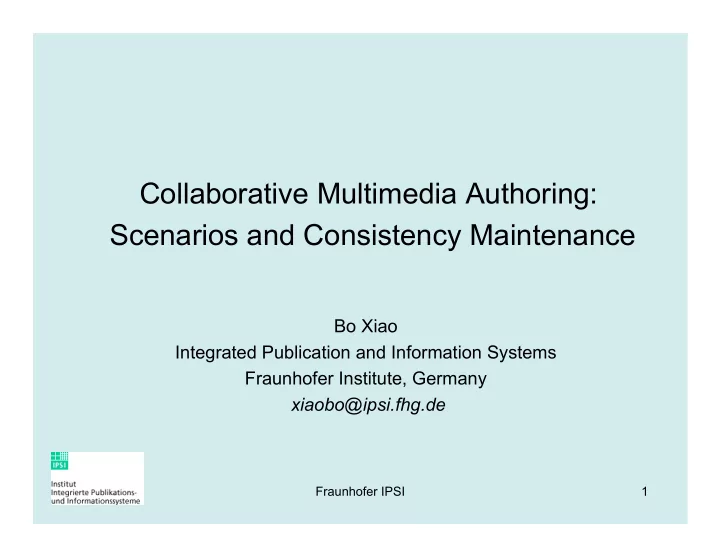

Collaborative Multimedia Authoring: Scenarios and Consistency Maintenance Bo Xiao Integrated Publication and Information Systems Fraunhofer Institute, Germany xiaobo@ipsi.fhg.de Fraunhofer IPSI 1
Motivation � Research in collaborative edting • Text, spreadsheet, graphics, XML, bitmap, etc. • Distributed discreet media presentation • What about editing time-based imedia collaboratively? � Research in multimedia • Distributed multimedia • Interactive multimedia � Collaborative multimedia • Interesting potential applications in areas such as media production, education, entertainment, business, and so on Fraunhofer IPSI 2
Scenario for Collaborative Multimedia � A team makes a movie cooperatively in a distributed setting. � Steps including pre-production, production, post-production. � The team might work back and forth on production and post-production tasks. � Tasks: to outline, script, capture, import, assemble, edit, composite and output Fraunhofer IPSI 3
Collaborative Multimedia Authoring � CMA (Collaborative Multimedia Authoring) • In a broad sense: the process for the preparation and consumption of digital media by a team for a defined goal • In a narrow sense: editing time-based media in the temporal and the spatial domains � Multimedia authoring mode (temporal) • Time-based mode • Relationship-based mode • Mixed mode Fraunhofer IPSI 4
CMA System Model � Three-layered model • Collaborative Authoring UI Layer • User view of a CMA environment • The track metaphor is used here. • Collaborative Media Interaction Layer • Logical model of time-dependent media • Collaborative Media Data Layer • Physical data: format, protocol, etc Fraunhofer IPSI 5
Model for CMA � Data model • A multi-track, temporal structured model • Tracks, media entities • Segments (time intervals), time points • Media entities do not overlap along the time axis. � Operation model • Primitive operations: insert and delete • Composite operations: move, cut, copy, paste, etc Fraunhofer IPSI 6
Operation Model � The “ insert ” operation • Semantics: inserting some media entities into a track at a time point • Effect: • New media entities are added to the set of media entities. • If new entities overlap existing entities, some of the existing entities will be “pushed” right. • In no circumstances will any entity be “pushed” left. Fraunhofer IPSI 7
Operation Model (Cont.) � The “ delete ” operation • Semantics: deleting media entities from a track. • Effect: • The media entities are removed from the set of media entities ; • After the deletion, there will be “empty segments” where the deleted entities once were. • Compatibility • The definition of “ insert ” and “ delete ” here are basically compatible with the counterparts in practical video editing tools, such as Adobe Premiere. Fraunhofer IPSI 8
Inconsistency Problem � In CMA, there can be inconsistency problems. As an example, • O 1 = insert(E 1 , T, P 1 ): insert a media entity E 1 to the track T at the timepoint of P 1 • O 2 = delete(E 2 , T): delete a media entity E 2 from the track T • There can be inconsistent results after concurrent performing of the operations Fraunhofer IPSI 9
Inconsistency Problem (Cont.) • Illustration of the example E 2 E 3 initial state E 1 E 1 to be inserted E 2 E 3 E 1 E 3 state after O 2 + O 1 E 1 E 3 state after O 2 + O 1 Fraunhofer IPSI 10
Approach � Applying operational transformation • The generic operational transformation algorithms will be used. • Transformation functions for specific domain semantics are needed. � Solving inconsistency problems in CMA • Identifying temporal relationships which is necessary • Designing transformation functions for the primitive operations • Applying the operational transformation method Fraunhofer IPSI 11
Part of The Solution � Temporal relationships • (a) before, (b) before with intersection, (c) containing, (d) contained by, (e) after with intersection, (f) after � Transformation function for the “insert” operation ( O 1 : insert, O 2 : delete) O 1 ′ = IT(O 1 , O 2 ) Relationship between Result of O 1 ′ E 1 and E 2 (a), (f) O 1 (d), (e) insert(E 1 , T, P(E 2 ) + L(E 2 )) O 1 , if E 2 is the leftmost one under (b) and (c) (b), (c) O 1 + insert(EMPTY_SEG) , otherwise Fraunhofer IPSI 12
Comparison � With graphic editing • Similarity: a few baisc graphic editing functions • Difference: contrained in the tracks, and no overlapping � With text editing • Similarity: “ insert” and “ delete ” as primitive operations • Difference: “empty segments” are different from spaces Fraunhofer IPSI 13
Future Work � Concurrency control in CMA systems � Low-level media issues � Spatial aspect of CMA � Undo/redo in CMA Fraunhofer IPSI 14
Thank you very much! Fraunhofer IPSI 15
Recommend
More recommend